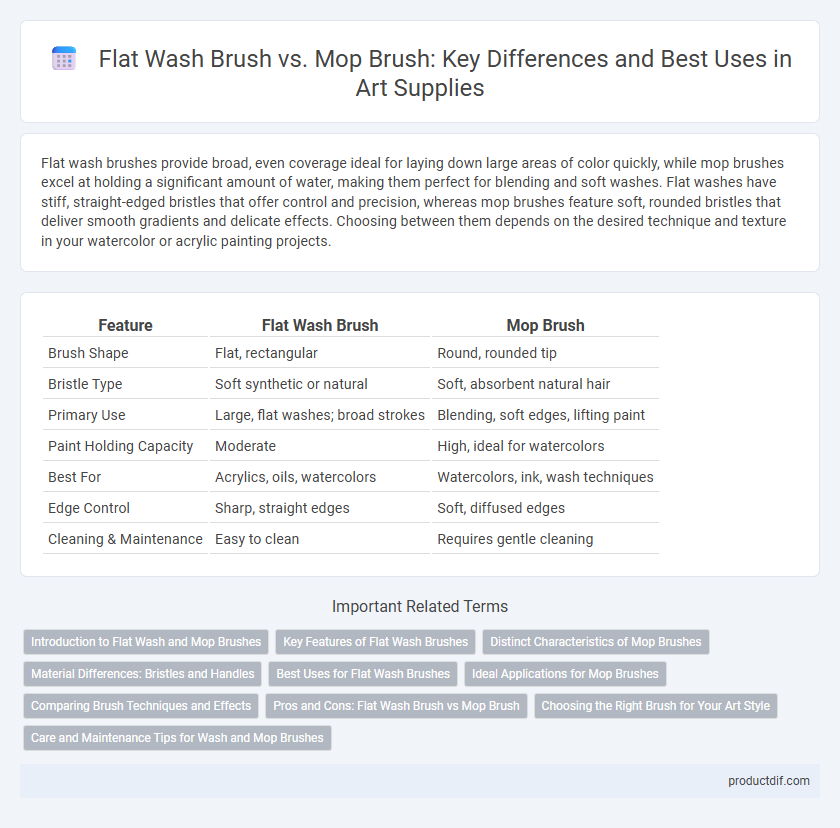Flat wash brushes provide broad, even coverage ideal for laying down large areas of color quickly, while mop brushes excel at holding a significant amount of water, making them perfect for blending and soft washes. Flat washes have stiff, straight-edged bristles that offer control and precision, whereas mop brushes feature soft, rounded bristles that deliver smooth gradients and delicate effects. Choosing between them depends on the desired technique and texture in your watercolor or acrylic painting projects.
Table of Comparison
| Feature | Flat Wash Brush | Mop Brush |
|---|---|---|
| Brush Shape | Flat, rectangular | Round, rounded tip |
| Bristle Type | Soft synthetic or natural | Soft, absorbent natural hair |
| Primary Use | Large, flat washes; broad strokes | Blending, soft edges, lifting paint |
| Paint Holding Capacity | Moderate | High, ideal for watercolors |
| Best For | Acrylics, oils, watercolors | Watercolors, ink, wash techniques |
| Edge Control | Sharp, straight edges | Soft, diffused edges |
| Cleaning & Maintenance | Easy to clean | Requires gentle cleaning |
Introduction to Flat Wash and Mop Brushes
Flat wash brushes feature broad, flat bristles that provide smooth, even coverage, ideal for large washes and backgrounds in watercolor painting. Mop brushes have soft, highly absorbent bristles designed to hold ample water and pigment, perfect for blending, glazing, and creating wet-on-wet effects. Artists often choose flat wash brushes for controlled, uniform strokes, while mop brushes excel in fluid, expressive washes.
Key Features of Flat Wash Brushes
Flat wash brushes feature a wide, flat bristle layout ideal for covering large surfaces with smooth, even washes of paint. Their stiff synthetic or natural bristles provide excellent control and precision in applying thin layers of color, making them perfect for backgrounds and base coats. The square edge of flat wash brushes allows for sharp, straight lines and easy blending in watercolor and acrylic painting techniques.
Distinct Characteristics of Mop Brushes
Mop brushes feature densely packed, soft, and absorbent hairs designed to hold a large amount of water or paint, enabling smooth, even washes and blending in watercolor techniques. Unlike flat wash brushes with their straight-edged bristles ideal for crisp, controlled strokes and sharp edges, mop brushes have rounded tips that facilitate gentle, broad strokes and subtle gradients. Their ability to retain moisture longer makes mop brushes essential for creating seamless transitions and soft background layers in fine art painting.
Material Differences: Bristles and Handles
Flat wash brushes feature synthetic bristles that provide firm, even strokes ideal for broad washes, paired with lightweight wooden handles designed for controlled, precise maneuvering. Mop brushes utilize soft, natural squirrel hair bristles that hold large amounts of water and pigment, combined with shorter, thicker handles that allow for gentle, sweeping motions and ease of grip during detailed wash techniques. The choice between these brushes depends on the desired brushstrokes and water retention needed in watercolor painting.
Best Uses for Flat Wash Brushes
Flat wash brushes excel in covering large areas with broad, even strokes, making them ideal for laying down backgrounds or washes in watercolor and acrylic painting. Their firm, flat bristles provide controlled edges and smooth blends, perfect for creating sharp lines and geometric shapes. Artists use flat wash brushes for blocking in colors quickly while maintaining precision in landscape and architectural artworks.
Ideal Applications for Mop Brushes
Mop brushes excel in watercolor and acrylic painting due to their ability to hold large amounts of water and pigment, making them ideal for creating smooth washes and soft blends. Their rounded bristle shape allows for gentle application on delicate surfaces and enables easy manipulation of paint for detailed gradients and subtle textures. Artists often use mop brushes for wet-on-wet techniques and for covering large areas evenly without streaks.
Comparing Brush Techniques and Effects
Flat wash brushes create smooth, even layers ideal for large backgrounds and gradients, while mop brushes hold more water, enabling softer, more diffused washes for delicate blending and glazing techniques. Flat wash brushes provide crisp edges and controlled strokes, making them suitable for precise shapes and hard lines, whereas mop brushes produce gentle, fluid transitions with minimal streaking. Choosing between these brushes depends on the desired texture and effect, with flat washes excelling in structured coverage and mop brushes enhancing subtle tonal shifts.
Pros and Cons: Flat Wash Brush vs Mop Brush
Flat wash brushes provide excellent coverage and are ideal for creating smooth, even washes with their stiff, synthetic bristles, but they can lack the softness needed for delicate blending. Mop brushes, made with soft natural hairs like squirrel or goat, excel at holding large amounts of water and paint, offering superior blending and smooth gradients, though they may be less precise for detailed strokes. Choosing between a flat wash and a mop brush depends on the painting technique, desired texture, and control needed for the artwork.
Choosing the Right Brush for Your Art Style
Flat wash brushes deliver broad, even strokes ideal for acrylic and oil painting techniques that require smooth coverage, while mop brushes excel in watercolor for their ability to hold large amounts of water and create soft, blended effects. Selecting the right brush depends on your preferred medium and style: flat wash brushes support controlled, consistent washes, whereas mop brushes facilitate gentle transitions and delicate gradients. Artists prioritizing precision and flat coverage benefit from flat wash brushes, whereas those exploring fluid, organic textures achieve optimal results with mop brushes.
Care and Maintenance Tips for Wash and Mop Brushes
Proper care and maintenance of flat wash brushes and mop brushes involve thorough cleaning with lukewarm water and mild soap immediately after use to prevent paint buildup and bristle damage. Both brushes require gentle reshaping of the bristles and drying them flat or hanging with bristles downward to maintain shape and extend lifespan. Regularly conditioning natural hair mop brushes with brush cleaner or conditioner enhances softness and durability for optimal painting performance.
Flat Wash Brush vs Mop Brush Infographic

 productdif.com
productdif.com